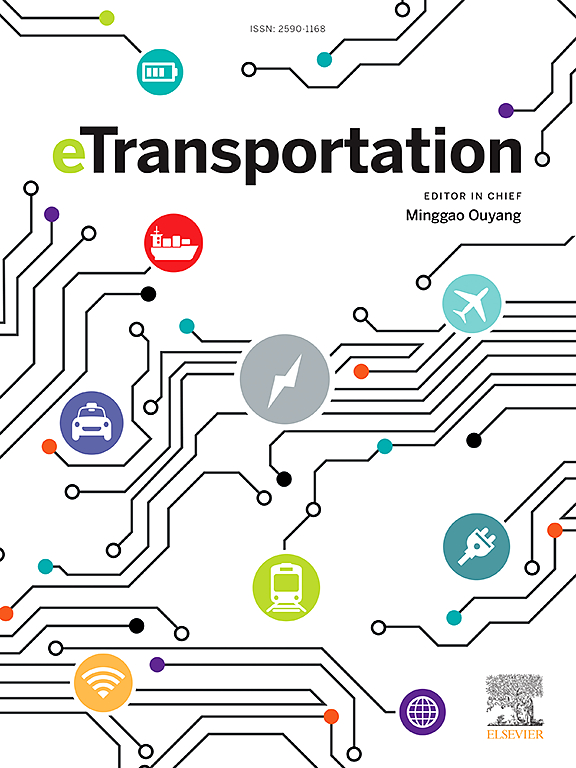Experimental investigation of the influence of venting gases on thermal runaway propagation in lithium-ion batteries with enclosed packaging
IF 17
1区 工程技术
Q1 ENERGY & FUELS
引用次数: 0
Abstract
Thermal runaway (TR) of lithium-ion batteries (LIBs) involves venting high-temperature combustible gases. Common enclosure-style battery packs without specialized venting can constrain these gases, potentially promoting thermal runaway propagation (TRP) within the module. To clarify the impact of unignited TR venting gases on TRP, this study conducted comparative experiments on LiFePO₄ modules with normal packaging (NP) and isolated venting packaging (IVP). In NP, the module’s top includes baffles allowing venting to spread, whereas IVP uses dedicated airflow channels to isolate venting. Quantitative analyses of TRP behavior, temperature, and mass loss rates were conducted under varying heating positions and states of charge (SOCs). Results indicated that NP modules exhibited faster TRP in all tests due to heat accumulation from venting gases in the semi-enclosed space between cell surfaces and packaging, compared to IVP. In the side heating scenario, TR behavior of SOC 100 % NP modules was more severe, with an average heat contribution from TR venting gases of front-end cells just before safety valve activation in back-end cells being 27.3 %, while not all cells underwent TR under IVP. Under intermediate heating, lower SOCs caused TR venting gas heat contribution to decrease from 27.4 % at SOC 100 %–8 % at SOC 50 %. These findings demonstrate that venting gases from TR cells significantly accelerate TRP in enclosed structures, highlighting the critical importance of packaging design for safety. Consequently, venting gases should be directed away from the module and effective thermal insulation measures implemented to reduce TRP risk.
排气对密闭封装锂离子电池热失控传播影响的实验研究
锂离子电池(lib)的热失控(TR)涉及到高温可燃气体的排放。没有专门排气口的普通外壳式电池组会限制这些气体,可能会促进模块内的热失控传播(TRP)。为了明确未点燃TR排气气体对TRP的影响,本研究对正常封装(NP)和隔离排气封装(IVP)的LiFePO₄模块进行了对比实验。在NP中,模块的顶部包括挡板,允许排气扩散,而IVP使用专用的气流通道来隔离排气。定量分析了不同加热位置和电荷状态下TRP的行为、温度和质量损失率。结果表明,与IVP相比,NP模块在所有测试中都表现出更快的TRP,这是由于在电池表面和封装之间的半封闭空间中排气产生的热量积累。在侧加热情况下,SOC 100% NP模块的TR行为更为严重,在后端电池安全阀激活之前,前端电池的TR排气气体的平均热量贡献为27.3%,而并非所有电池在IVP下都发生了TR。在中等加热条件下,较低的SOC导致TR排气热贡献从SOC 100%时的27.4%下降到SOC 50%时的8%。这些发现表明,从TR单元排出的气体显著加速了封闭结构中的TRP,突出了包装设计对安全的至关重要性。因此,排气应远离模块,并实施有效的隔热措施,以减少TRP风险。
本文章由计算机程序翻译,如有差异,请以英文原文为准。
求助全文
约1分钟内获得全文
求助全文
来源期刊

Etransportation
Engineering-Automotive Engineering
CiteScore
19.80
自引率
12.60%
发文量
57
审稿时长
39 days
期刊介绍:
eTransportation is a scholarly journal that aims to advance knowledge in the field of electric transportation. It focuses on all modes of transportation that utilize electricity as their primary source of energy, including electric vehicles, trains, ships, and aircraft. The journal covers all stages of research, development, and testing of new technologies, systems, and devices related to electrical transportation.
The journal welcomes the use of simulation and analysis tools at the system, transport, or device level. Its primary emphasis is on the study of the electrical and electronic aspects of transportation systems. However, it also considers research on mechanical parts or subsystems of vehicles if there is a clear interaction with electrical or electronic equipment.
Please note that this journal excludes other aspects such as sociological, political, regulatory, or environmental factors from its scope.
 求助内容:
求助内容: 应助结果提醒方式:
应助结果提醒方式:


